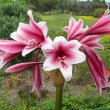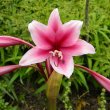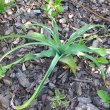Crinum bulbispermum
| Botanical Name | Crinum bulbispermum |
|||||||||||||||||||||
| Family | Amaryllidaceae - The amaryllis family. |
|||||||||||||||||||||
| Pronunciation | KREE-num / KRY-num bulb-ee-SPUR-mum |
|||||||||||||||||||||
| Common Name(s) |
English: Orange River Lily; Vaal River Lily;
Afrikaans: Oranjerivierlelie; Vaalrivierlelie; Vleilelie
IsiZulu: Umnduze
Sesotho: Lelutla; Mototse
Setswana: ,Mototse
|
|||||||||||||||||||||
| Plant Group |
|
|||||||||||||||||||||
| Plant Size |
|
|||||||||||||||||||||
| Position |
|
|||||||||||||||||||||
| General Information |
|
|||||||||||||||||||||
| Specific Information | Crinum bulbispermum is a large bulbous plant which is easily recognised in spring and summer by the blue- to grey-green, gracefully arching tapered leaves which cascade about the plant. The bulbs are large (8 to 10 cm wide), oval shaped and may have a neck of about 15 cm long. They are covered by many layers of papery dry bulb scales, which protect them from drying out during the dry winter months. The plants begin to bloom early in the growing season in spring, lasting for a month or more. The flowers are heavily scented, often being described as 'sickly-sweet' and are pollinated by insects. The flowers are followed by large, fleshy seeds contained in a covering that becomes papery as the seeds ripen. As the flower stem becomes heavier, it keels over and the seeds are released to fall onto the ground where they immediately begin to germinate. The foliage grows to about 0.5 m with the flowering stems reaching up to a meter, with a spread of over a meter in mature plants. As autumn approaches the leaves turn from yellow to brown and papery and remain as a mulch around the bulbs to return the nutrients to the soil and to protect the bulbs during the winter months. Crinum bulbispermum is threatened by harvesting for the medicinal plant trade which has resulted in a continuing decline of numbers in its natural environment. |
|||||||||||||||||||||
| Ad Break | ||||||||||||||||||||||
| Flowers | ||||||||||||||||||||||
| Description | large, funnel-shaped, lily-type flowers about 15 cm across, in clusters of 5 - 8, at the top of a thick, fleshy stalk up to a meter in height |
|||||||||||||||||||||
| Season |
|
|||||||||||||||||||||
| Colour |
|
|||||||||||||||||||||
| Growth Rate |
|
|||||||||||||||||||||
| Plant Uses |
|
|||||||||||||||||||||
| Distribution and Habitat | from the Northern Cape Province, eastwards to the provinces of the Free State, Gauteng, KwaZulu-Natal, Mpumalanga and North West as well as in Lesotho, in grasslands and Savanna, on the banks of freshwater rivers, streams, dams, seasonal pans, permanent to seasonal swampy grasslands and in damp depressions, in deep soils |
|||||||||||||||||||||
| Planting Suggestions | Crinum bulbispermum is happiest in full sun with plenty of water in spring and summer. Bulbs are best grown in deep, heavy soils that receive and retain a lot of water during the growing season. Plant the bulbs with the top of the bulb just above the soil surface and keep moist from the time the foliage appears until the the flowers have finished. Withhold water during the dormant seasons of autumn and winter. This is a greedy feeder: from time to time surround the plants with compost and a thick covering of mulch and if needed, use an organic, slow release fertiliser according to the manufacturer's instructions. The plant can endure periods of drought during the growing season without adverse effects. It is also frost hardy and will tolerate periods of icy weather. In their natural environment they survive summer temperatures of up to 40°C and cold dry winters to -8°C. In areas where temperatures drop below this level it would be wise to use containers to afford protection from freezing ground. Careful consideration should be given to positioning as the bulbs should be left to grow in the same place without disturbance for a few years. With age the bulbs will form a clump and after some years the bulbs can be lifted and gently separated. Propagation from seed is easy and successful and plants will flower after three or four years. Seeds must be planted fresh. Sow in deep trays or directly into the garden. They can be covered with a light layer of soil but I simply place them on the soil mixture and cover them loosely with some of the dead leaves from the mother plants.
The leaves, seeds and bulbs are highly susceptible to attack by Amaryllis caterpillars which cause a great deal of damage or death of even well established plants. Ensure that these pests do not get the opportunity to burrow down into the bulb. An organic compound for the control of caterpillars is now available for those who prefer to keep poisonous chemicals out of the environment.
|
|||||||||||||||||||||
| Medicinal Uses | Crinum bulbispermum is used in traditional healing for the common cold and to stimulate breast milk. Roasted bulbs are used for aching joints, rheumatism, varicose veins and backache. Poultices are applied to septic sores. The leaves are used to keep dressings in place and the flowers are placed on sprains to reduce swelling. It is also planted to protect homes from evil. |
|||||||||||||||||||||
| Ad Break | ||||||||||||||||||||||








Comments
thanks
thanks, wondered what it was called and now I know ;)
Discuss this plant
Share knowledge, ask a question or give an experience.